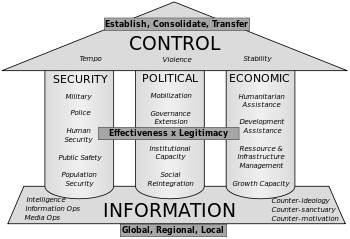Introduction
In the realm of decision-making, our minds often fall prey to subtle biases and mental traps that hinder our ability to make rational choices. One such cognitive bias, known as the Counterinsurgency mental model, exerts a pervasive influence on our everyday lives. Originating from military strategy, this mental model has found its way into various contexts, including personal life decisions, business scenarios, and public policy-making. By understanding the mechanisms behind this bias and learning to identify its manifestations, we can take proactive steps to avoid its pitfalls and make better-informed decisions.
Defining Counterinsurgency and its Relevance
The Counterinsurgency mental model can be defined as a cognitive bias where individuals or groups, instead of focusing on their primary objectives or challenges, become preoccupied with minor, distracting issues. This fixation leads to a diversion of resources, attention, and effort away from the main goals, resulting in ineffective decision-making and failure to achieve desired outcomes.
This mental model’s relevance lies in its ability to hinder objective decision-making by captivating our attention with peripheral or inconsequential matters. By understanding how and why this bias operates, we can guard against its impact and make decisions that align with our best interests.
Human Psychology and Counterinsurgency
Counterinsurgency has deep psychological roots, primarily stemming from our inclination to be reactive and prone to distraction. Our minds are wired to respond to immediate threats or distractions, often at the expense of important long-term goals. This evolutionary trait, while helpful in survival situations, can lead to misguided decision-making in modern, complex environments.
Furthermore, the prevalence of Counterinsurgency in our day-to-day lives is exemplified by its manifestation across multiple contexts. Let’s explore three distinct examples that illustrate the occurrence of Counterinsurgency and its detrimental consequences:
Personal Life Decisions: Sarah, an aspiring writer, spends countless hours meticulously organizing her writing desk, exploring various writing software, and seeking inspiration from others’ work. While these activities may have some value, they divert her attention from the most crucial task—writing itself. Sarah falls into the Counterinsurgency trap by obsessing over peripheral aspects, leaving her with little time and energy to pursue her true passion.
Business Scenarios: A company facing financial difficulties focuses extensively on minimizing costs by reducing employee benefits, cutting research and development budgets, and downsizing. While these actions may provide short-term relief, the company neglects to address the underlying problems affecting their core business strategy and fails to invest in innovation and growth. In this case, the Counterinsurgency bias shifts the organization’s attention away from long-term sustainability and stifles its ability to adapt and thrive.
Public Policy-Making: Governments may fall prey to Counterinsurgency by overreacting to short-term crises or public sentiment without considering the long-term consequences. This can lead to hastily implemented policies that fail to address the root causes or achieve meaningful societal progress. By succumbing to this mental model, decision-makers prioritize immediate concerns over comprehensive, well-thought-out solutions.
Mental Biases and Psychological Underpinnings
Counterinsurgency is often fueled by a combination of mental biases that amplify its effects. Some of the key biases that contribute to this mental model include:
Availability Bias: Our minds tend to overemphasize the significance of information that is readily available to us. As a result, we become fixated on easily accessible peripheral details rather than the broader context, leading to Counterinsurgency.
Sunk Cost Fallacy: The inclination to continue investing in a failing endeavor due to previously invested time, effort, or resources can trap us in Counterinsurgency. We may prioritize salvaging sunk costs over objectively evaluating the current situation and making optimal decisions for the future.
Confirmation Bias: We have a tendency to seek information that supports our pre-existing beliefs or preferences. This bias reinforces Counterinsurgency by diverting our attention toward evidence that aligns with peripheral distractions, rather than critically evaluating the larger picture.
In addition to these biases, cognitive overload, fear of missing out, and social pressure also contribute to the allure of Counterinsurgency.
Identifying and Avoiding Counterinsurgency
To avoid falling into the Counterinsurgency mental model, it is crucial to cultivate self-awareness and practice objective decision-making. Here are some practical strategies to identify and combat this bias:
Define Clear Objectives: Clearly articulate your primary objectives and long-term goals. Establishing a clear vision allows you to discern between essential tasks and peripheral distractions.
Prioritize and Evaluate: Regularly reassess your activities and align them with your defined objectives. Prioritize tasks that directly contribute to your core goals while objectively evaluating the importance and relevance of peripheral activities.
Seek Diverse Perspectives: Actively seek alternative viewpoints and gather diverse information before making decisions. Encouraging dissenting opinions and engaging in constructive debates can help break free from confirmation bias and broaden your perspective.
Embrace Deliberate Thinking: Take the time to reflect and evaluate your decisions rather than impulsively reacting to immediate stimuli. Deliberate thinking enables you to consider the broader implications of your choices and avoid being caught in the Counterinsurgency trap.
Conclusion
The Counterinsurgency mental model poses a significant challenge to objective decision-making, leading individuals and organizations astray. By recognizing the presence of this bias in our lives and understanding its psychological underpinnings, we can actively avoid its pitfalls. Armed with practical strategies and an awareness of our own cognitive biases, we can make more informed choices that align with our long-term objectives. Counterinsurgency may persist in our everyday lives, but with vigilance and deliberate action, we can navigate through the distractions and make decisions that drive us towards success.
